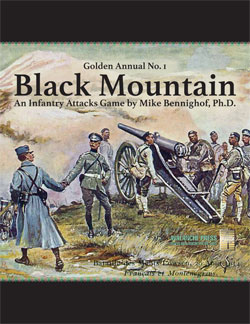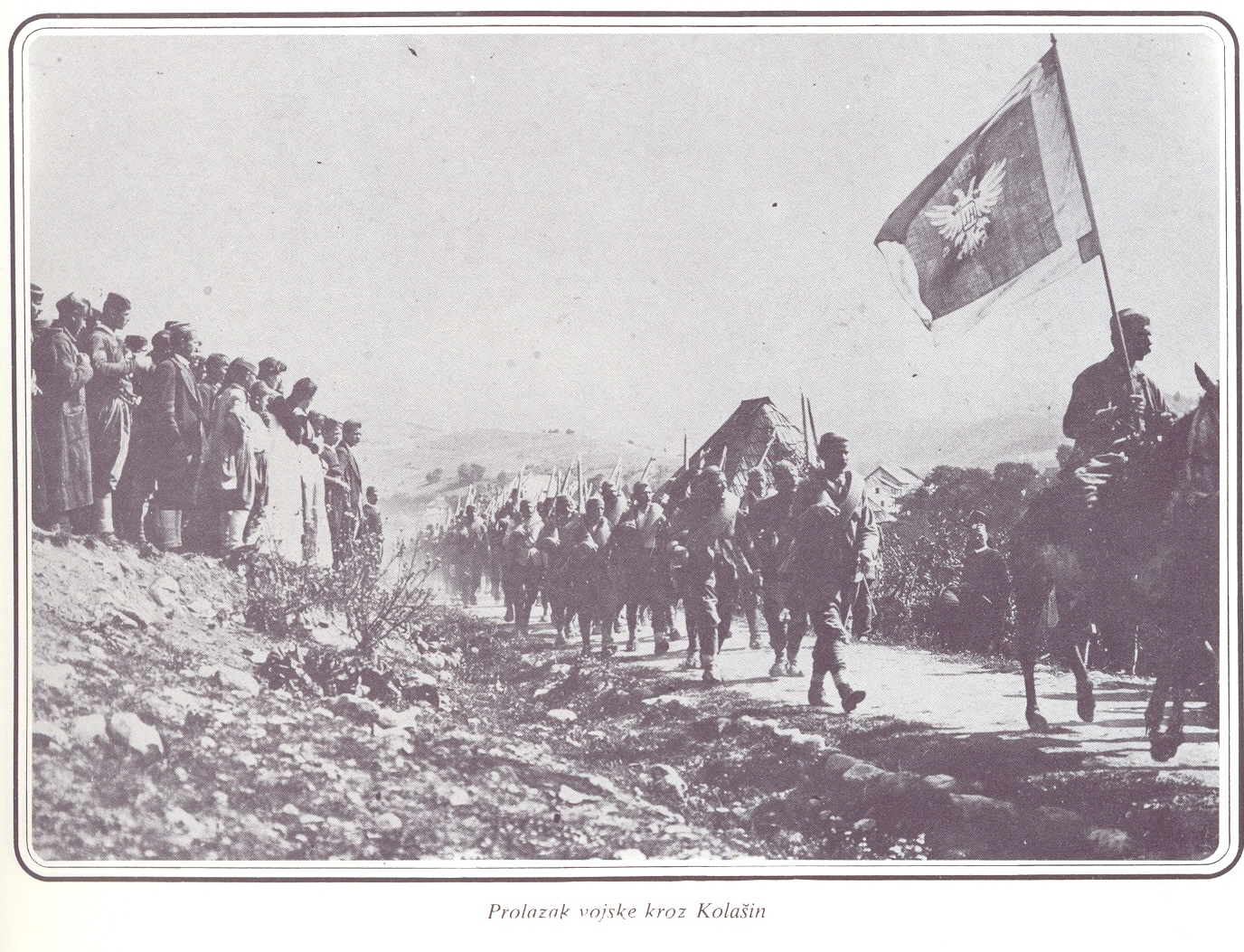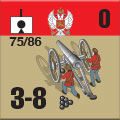| Infantry Attacks: Black Mountain
The Army of Montenegro
By Mike Bennighof, Ph.D.
May 2022
 Mobilization in Montenegro consists of doling out cartridges from the magazines, for every man always has with him his rifle and equipment. Mobilization in Montenegro consists of doling out cartridges from the magazines, for every man always has with him his rifle and equipment.
-Times of London, 9 October 1912
Montenegro’s army mobilized for war on 28 July 1914, the same day that neighboring Austria-Hungary declared war on Serbia and commenced partial mobilization. Montenegro’s parliament met in special session on 1 August to vote overwhlemingly for war against Austria-Hungary, but 72-year-old King Nikola fended them off until finally the political and public pressure became too great, issuing the declaration of war on 7 August.
Montenegro had fought in the First Balkan War as part of the anti-Turkish coalition. The hyper-aggressive Montenegrins declared war two weeks before their Balkan allies did so, so as not to miss the opportunity to declare war on the king’s birthday. They hoped to conquer much of northern Albania, but eventually – after the Great Powers imposed a peace settlement - had to be satisfied with relatively small pieces of Turkish Albania not including their prize, the fortress of Shköder. The big gains for the tiny kingdom came in the Sanjak of Novi-Pazar, usually just called “the Sanjak.”
The Sanjak lay between Montenegro and Serbia, forming a land bridge between Bosnia-Hercegovina and Macedonia. Austria-Hungary occupied the tiny province in 1878 along with Bosnia and Hercegovina, but evacuated it when the Dual Monarchy annexed Bosnia-Hercegovina in 1908, a gesture to the Ottoman government that Vienna came to deeply regret.
Rather than placate potential enemies, the return of the Sanjak to Turkish rule guaranteed that at some point in the near future, Montenegro and Serbia would launch a war of conquest aimed at the Sanjak. That came in October 1912 with the outbreak of the First Balkan War, which ended in May 1913. Montenegro and Serbia divided the Sanjak between them, greatly enlarging Montenegro and bringing the two Slavic allies a common border.

Infantry march out of Kolasin, Montenegro,
bound for war. October 1912.
Montenegro had a small regular army: a Royal Guard of one rifle company and one cavalry platoon, and three regular infantry battalions. Most of the Montenegrin forces were a militia, called to the colors only for war; the three regular battalions provided the instructors for annual training.
In July 1914 Montenegro initially mobilized about 35,000 men – even the army command, headed by the king himself with Janko Vukotic as chief of staff, was unsure exactly how many men reported for duty. The army had ended the Balkan Wars with four infantry divisions, and was in the process of establishing two new ones in the newly-annexed Sanjak when the new war began.
Montenegrin divisions had both names and numbers, the names corresponding to their peacetime headquarters. Each division had two or three brigades, themselves also bearing names and numbers, with the names also corresponding to the brigade’s peacetime headquarters. Since some brigades shared their headquarters location with their parent division, this led to some confusion among both allies and enemies, and sometimes the Montenegrins themselves.
The Infantry
 
Both divisions and brigades were mostly ad-hoc structures to command the independent battalions that fleshed them out. A Montenegrin battalion consisted of four rifle companies, each with a nominal 200 men. Initially the Montenegrins raised 62 battalions; a little quick math shows that many if not all of them were considerably understrength when they marched to war.
Montenegro had purchased 30,000 modern Russian-made Moisin-Nagant 7.62mm bolt-action rifles just before the First Balkan War. Called “Moscow girls” by the troops, they equipped the regulars and the most favored of the militia. The Montenegrins had also purchased 30,000 7.58mm Berdan breech-loading, single-shot back powder rifles between 1895 and 1898. Prior to that, Montenegro had purchased 20,000 Austrian-made Werndl breech-loading, single-shot black powder rifles in 1880. Rounding out the arsenal were battlefield pickups from the Balkan Wars.
As the Times of London noted, Montenegrin men – it’s somewhat of a stretch to call them “reservists” – kept their rifles at home. When they reported for war, the Army issued ammunition and uniforms to them. They also brought their fighting knives, though the rifles had all been issued with bayonets.
On paper at least, all Montenegrin men entered the Army for training in the year of their 18th birthday. While they had a twelve-month obligation during their 18th and 19th years, in practice they only reported for training for two months during each of these years. At age 20 they entered the active reserve, subject to up to two weeks’ training each year (limited by law); in practice, once again, they usually received less than this. Each company was expected to report for drill one Sunday each month as well, though this was often cancelled.
Thanks to heavy combat during the Balkan Wars, the Montenegrins had considerable combat experience when they went to war in August 1914. Their lack of formal organization made them brittle in combat, but they did not shy away from hand-to-hand fighting. Officers came from experienced leaders promoted during the Balkan Wars, from the Russian-staffed cadet school in the capital, Cetinje, or via transfer from the Royal Serbian Army.
The Montenegrins had a well-earned reputation for savagery. In the initial battles they routinely mutilated Austrian wounded, with a particular yen for roasting a helpless prisoner’s head over open flame. They also massacred Muslim and Catholic civilians. The Austrians retaliated by formed a Schutzkorps of about 11,000 men, most of them Muslim, who carried out brutal reprisals against Orthodox civilians on both sides of the border. When men resident on the Austrian border were said to have crossed over the join the Montenegrins, the Austrian authorities hanged hundreds of Orthodox men of military age as potential traitors. The seeds of the 1990’s massacres in these same villages were sown in 1914.
Heavy Weapons
.jpg) 
Montenegro went to war in August 1914 almost exclusively with rifle-armed militia infantry. The order for Moisin-Nagant rifles also included enough Russian-made Maxim machine guns to give each battalion a section of two guns – as many as most of the better-equipped armies of August 1914.
In practice, many battalions had not yet received their guns when they marched to the front – the machine-gunners were trained with the artillerymen, separate from the rifle companies. The machine-gunners and artillerymen received slightly more training than the riflemen – two three-month periods, as opposed to two-month periods for the infantry.
On paper, each of the six divisions was to have four artillery batteries: two of field guns, one of mountain guns and one of heavy guns, all of four guns each. Not every division even had these guns, and not all of the batteries that did exist had sufficient trained gunners. The weapons themselves ranged from ancient muzzle-loaders seized from the Turks to the modern Russian-made M1902 76.2.mm field gun. The most common weapon in August 1914 seems to have been the Krupp-made 75mm Model 1886 mountain gun, and that’s what we provided in Infantry Attacks: Black Mountain.
Just like the Golden Journal, the Golden Annual is only available to the Gold Club (that’s why we call it the Golden Annual). We print enough of them to handle initial demand and a few extras, but once they’re gone we’re not likely to reprint them – there’s just no profit in a company as small as Avalanche Press keeping a $34.99 item perpetually in stock. If you want your fighting Montenegrins, the time to grab it is now.
Click here to join the Gold Club.
See your Gold Club Insider newsletter for ordering information.
Sign up for our newsletter right here. Your info will never be sold or transferred; we'll just use it to update you on new games and new offers.
Mike Bennighof is president of Avalanche Press and holds a doctorate in history from Emory University. A Fulbright Scholar and NASA Journalist in Space finalist, he has published a great many books, games and articles on historical subjects; people are saying that some of them are actually good.
He lives in Birmingham, Alabama with his wife and three children.
Want to keep Daily Content free of third-party ads? You can send us some love (and cash) through this link right here. |
